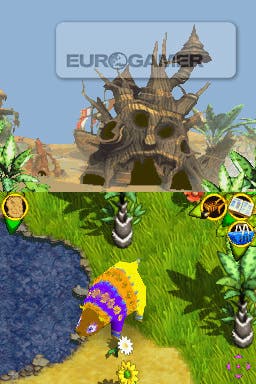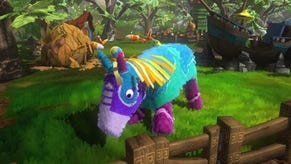Viva Piñata: Pocket Paradise
Filled with fun. And a new interface.
It also lets you admire their beautifully reduced forms, lacking nothing in colour, character or craftsmanlike texture next to their 360 and PC brethren. Only a slight fussiness when zoomed out mars the game's gorgeous representation of the garden in Pocket Paradise.
The top screen is much more plain, hosting information, and quite a lot of it. A news ticker keeps you abreast of new events: appearances of new species, or the fact that your Whirlms can't get home after an over-enthusiastic bout of landscape gardening. Context-information boxes give you some relevant feedback on whatever you're doing or studying, such as the residency or romance requirements of the piñata you've selected, or the percentage of water in your garden if you're digging a pond.
Even better, tapping a small icon pauses life in the garden and swaps the top screen and bottom and allows you to interact directly with the information page - click on any icon and it will take you to the relevant section of the encyclopaedia, which can also be browsed independently. There's a whole system of piñata awards - achievements, in short - and a pyramid graphic showing your piñata collection.
It's not exactly a pretty interface - nor a perfectly elegant one, although it's not far off, and it's certainly perfectly logical. But the ease and speed of use of Pocket Paradise will be a revelation to those who played the laborious, if completely beguiling, 360 release. Even those who played it on PC might find this DS version a faster, more precise game that's more direct in its rewards. Nonetheless, Rare's developers are designers of games, not websites, so their efforts to improve and tailor their game shouldn't stop at usability. And they don't.

Rare (and Microsoft) are keen to expand the audience of Viva Piñata, and get past the troubling hurdle to accessibility represented by its wordy and complex tutorial. Pocket Paradise's training episodes, hosted by the four sweet-stuffed stars of the cartoon, could not be more winsome and plain-speaking if they tried, and though they might grate for experienced paper gardeners, they do a very necessary job and do it well. But a more vital - and universally welcome - addition comes in the form of Playground mode.
This beach-themed holiday from the pressures of modern gardening is a pure, unstructured piñata sandbox. It's a chance to enjoy the brilliant creature designs and their interactions, as well as the game's creative toolset, entirely free of the complex strategic checks and balances that sometimes weigh the main game down, and yet make it what it is.
Recognising, rightly, that it couldn't simplify Viva Piñata without neutering it, Rare has provided a generous plaything that is shared between all the save slots on a cart, and has access to all features and piñata unlocked in those slots. (Gardeners can also copy their pocket ecologies across from one slot to another, allowing them to experiment with branching garden designs and creature collections.)
As sweet and welcoming as Playground is, it's hard to imagine most Pocket Paradise players - aside from the very, very young ones - spending much time with it. The remorselessly addictive pull of developing your own garden, well known to players of the 360 and PC versions, is just too strong. Pocket Paradise presents it in condensed form: a little crowded perhaps, a bit halting in some of the piñata interactions, but a purer, denser, more effortless and efficient satisfaction of your sugar-coated cravings than ever before. Sweet tooths beware.
Viva Piñata: Pocket Paradise is due out on DS later this year.










